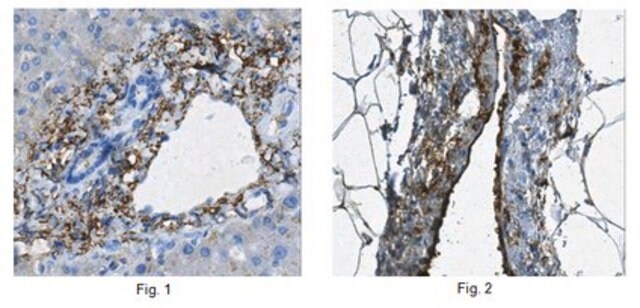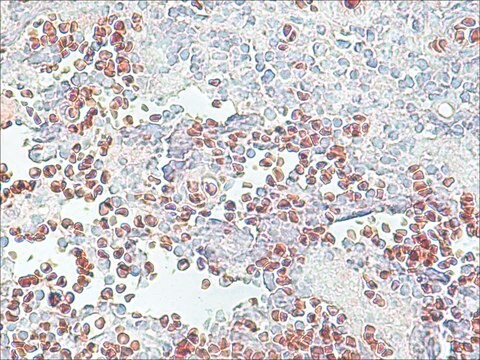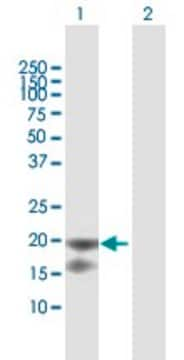MABT401
Anti-Lubricin Antibody/Proteoglycan 4, clone 9G3
clone 9G3, from mouse
Synonym(e):
Proteoglycan 4, Lubricin, Megakaryocyte-stimulating factor, Superficial zone proteoglycan, Proteoglycan 4 C-terminal part
About This Item
Empfohlene Produkte
Biologische Quelle
mouse
Qualitätsniveau
Antikörperform
purified immunoglobulin
Antikörper-Produkttyp
primary antibodies
Klon
9G3, monoclonal
Speziesreaktivität
rat, human
Methode(n)
immunohistochemistry: suitable (paraffin)
western blot: suitable
Isotyp
IgG1κ
NCBI-Hinterlegungsnummer
UniProt-Hinterlegungsnummer
Versandbedingung
wet ice
Posttranslationale Modifikation Target
unmodified
Angaben zum Gen
human ... PRG4(10216)
Allgemeine Beschreibung
Immunogen
Anwendung
Immunohistochemistry Analysis: A representative lot detected Lubricin/Proteoglycan 4 in articular cartilage tissue (Elsaid, K.A, et al. (2012). Osteoarthritis and Cartilage. 20:940-948).
Immunohistochemistry Analysis: A representative lot detected Lubricin/Proteoglycan 4 in rat arterial cartilage tissue (Jay, G.D, et al. (2012). Arthritis & Rheumatism. 64(4):940-948).
Immunohistochemistry Analysis: A representative lot detected Lubricin/Proteoglycan 4 in articular cartilage from rat
(Manuscript in preparation).
Western Blotting Analysis: A representative lot detected Lubricin/Proteoglycan 4 in lubricin purified from synovial fluid of patients (Manuscript in preparation).
Qualität
Western Blotting Analysis: 0.02 µg/mL of this antibody detected Lubricin/Proteoglycan 4 in 1 µg of Lubricin purified protein.
Zielbeschreibung
Physikalische Form
Sonstige Hinweise
Not finding the right product?
Try our Produkt-Auswahlhilfe.
Empfehlung
Lagerklassenschlüssel
12 - Non Combustible Liquids
WGK
WGK 1
Flammpunkt (°F)
Not applicable
Flammpunkt (°C)
Not applicable
Analysenzertifikate (COA)
Suchen Sie nach Analysenzertifikate (COA), indem Sie die Lot-/Chargennummer des Produkts eingeben. Lot- und Chargennummern sind auf dem Produktetikett hinter den Wörtern ‘Lot’ oder ‘Batch’ (Lot oder Charge) zu finden.
Besitzen Sie dieses Produkt bereits?
In der Dokumentenbibliothek finden Sie die Dokumentation zu den Produkten, die Sie kürzlich erworben haben.
Unser Team von Wissenschaftlern verfügt über Erfahrung in allen Forschungsbereichen einschließlich Life Science, Materialwissenschaften, chemischer Synthese, Chromatographie, Analytik und vielen mehr..
Setzen Sie sich mit dem technischen Dienst in Verbindung.






